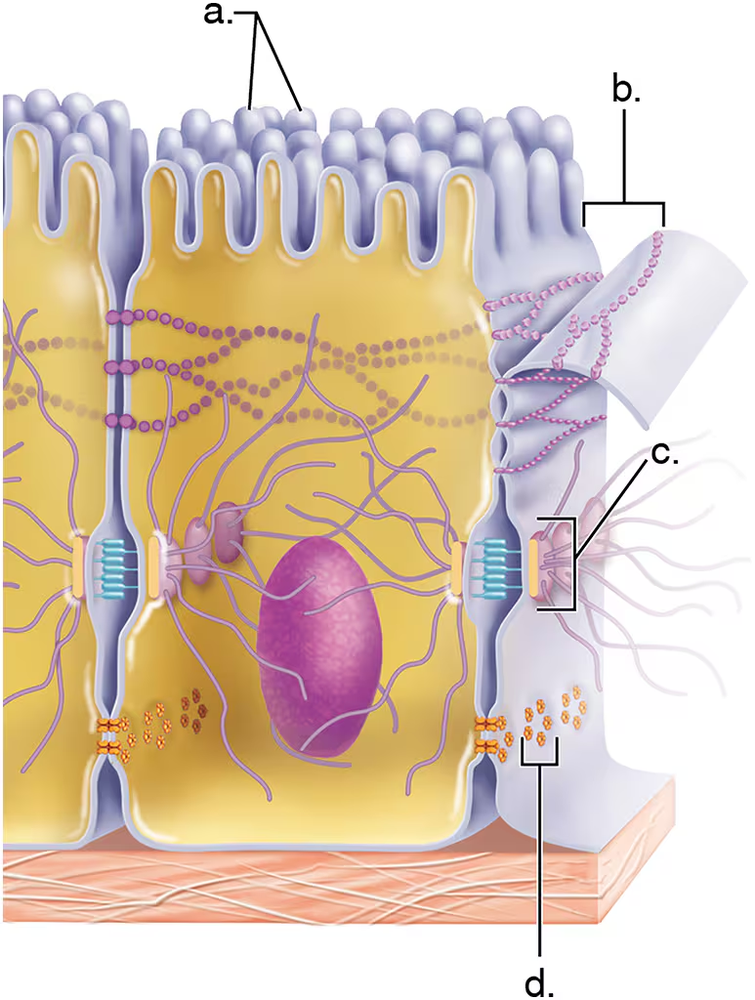 Back
BackProblem 1
Which of the following would you expect to find in or on cells whose main function is absorption?
Problem 2
Adult cell types you might expect to have gap junctions include:
a. Skeletal muscle
b. Bone
c. Heart muscle
d. Smooth muscle
Problem 3
Which of the following are possible functions of the glycoproteins in the plasma membrane?
a. Determination of blood groups
b. Binding sites for toxins or bacteria
c. Aiding the binding of sperm to egg
d. Increasing the efficiency of absorption
Problem 4
A cell with abundant peroxisomes would most likely be involved in:
a. Secretion
b. Storage of glycogen
c. ATP manufacture
d. Movement
e. Detoxification activities
Problem 5
A cell stimulated to increase its steroid production will have abundant:
a. Ribosomes
b. Rough ER
c. Smooth ER
d. Golgi apparatus
e. Secretory vesicles
Problem 6
For diffusion to occur, there must be:
a. A selectively permeable membrane
b. Equal amounts of solute
c. A concentration difference
d. Some sort of carrier system
e. All of the above
Problem 7
In which of the following tissue types might you expect to find goblet cells?
a. Simple cuboidal
b. Simple columnar
c. Simple squamous
d. Stratified squamous
e. Transitional
Problem 8
Which epithelium is 'built' to withstand friction?
a. Simple squamous
b. Stratified squamous
c. Simple cuboidal
d. Simple columnar
e. Pseudostratified
Problem 9
What kind of connective tissue acts as a sponge, soaking up fluid when edema occurs?
a. Areolar connective
b. Adipose connective
c. Dense irregular connective
d. Reticular connective
e. Vascular
Problem 9a
Match the appropriate structure with the proper description and/or function.
1. Made of dense, irregular connective tissue
2. Produce sebum
3. Helps regulate body temperature by producing sweat
4. Cause fingerprints
5. Houses the hair root
6. Superficial keratinized stratified squamous epithelium
7. Deep pressure receptors
8. Vascular layer that houses skin appendages
a. Dermal papillae
b. Lamellar corpuscles
c. Dermis
d. Hair follicle
e. Epidermis
f. Eccrine sweat gland
g. Reticular layer
h. Sebaceous glands
Problem 10
What kind of connective tissue prevents muscles from pulling away from bones during contraction?
a. Dense connective
b. Areolar
c. Elastic connective
d. Hyaline cartilage
Problem 10
What is the name of the connective tissue membrane found lining the joint cavities?
Problem 13
Although cells have differences that reflect their special functions in the body, what functional abilities do all cells exhibit?
Problem 14
Describe the four structural components of the plasma membrane and the function of each.
Problem 15
Name the cellular organelles, and explain the function of each.
Problem 17
Describe the general characteristics of epithelial tissue. List the most important functions of epithelial tissues, and give examples of each.
Problem 18
What are the general structural characteristics of connective tissues? What are the functions of connective tissues? How are their functions reflected in their structures?
Problem 20
Contrast cytokinesis, interphase, and mitosis.
Problem 21
Hydrocortisone is an anti-inflammatory drug that stabilizes lysosomal membranes. Explain how this effect reduces cell damage and inflammation.
Problem 23
Think carefully about the chemistry of the plasma membrane, and then answer this question: Why is minor damage to the membrane usually not a problem?

